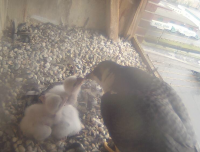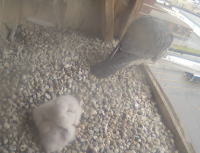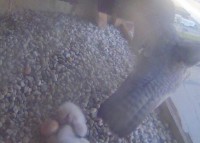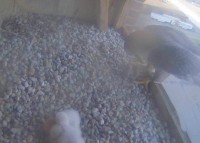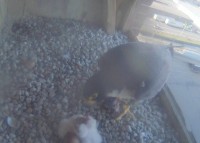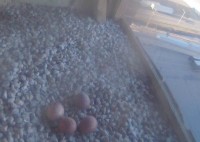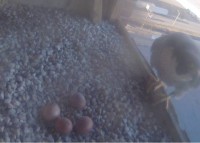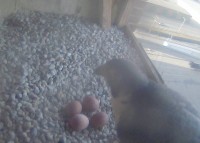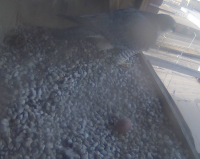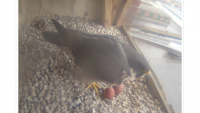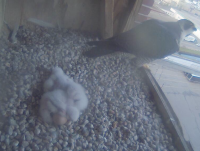 The forecast for today calls for a chance of rain, mainly after 4pm. Mostly cloudy, with a high near 53. Light northeast wind becoming east 8 to 13 mph in the morning. Winds could gust as high as 24 mph. Chance of precipitation is 30%. For tonight, rain, mainly after 7pm, fog after midnight, low around 39F. Northeast wind around 10 mph, with gusts as high as 23 mph. The nest box faces to the west, so the chicks will be out of the direct wind. The female will start taking more breaks like this, from active brooding.
The forecast for today calls for a chance of rain, mainly after 4pm. Mostly cloudy, with a high near 53. Light northeast wind becoming east 8 to 13 mph in the morning. Winds could gust as high as 24 mph. Chance of precipitation is 30%. For tonight, rain, mainly after 7pm, fog after midnight, low around 39F. Northeast wind around 10 mph, with gusts as high as 23 mph. The nest box faces to the west, so the chicks will be out of the direct wind. The female will start taking more breaks like this, from active brooding.
Now let’s take a look at an overview of growth and development over the total 40 days. Here’s a bit of what to expect:
At 5 days after hatch, their mass has doubled. The eyas can sit with relative ease, and the open eyes are more round.
At 6–8 days of age the second down (mesoptile or preplumulae) starts to emerge, first on humeral and alar tracts but no down visible on belly at 6 day, although on the legs and belly at 8 days. Also second down is well out on the wings and looks a bit blueish and sheaths of primaries breaking skin on wings.
By 10 days of age the second down is complete and uniform and outer rectrices are breaking skin. At 10 days, primaries growing at 2–3 mm/d, rectrix sheath not yet split.
At 14 days the second down is dense and long, rectrix sheath about 2 mm and typically ninth primary emerges from sheath.
By day 17 the contour feathers start to push out prepennae and only pale (buffy) tips of rectrices have emerged but growing at about 2 mm/d (since day 13).
By 10 days of age the second down is complete and uniform and outer rectrices are breaking skin. At 10 days, primaries growing at 2–3 mm/d, rectrix sheath not yet split.
At 14 days the second down is dense and long, rectrix sheath about 2 mm and typically ninth primary emerges from sheath.
By day 17 the contour feathers start to push out prepennae and only pale (buffy) tips of rectrices have emerged but growing at about 2 mm/d (since day 13).
At 20 days while still with heavy coat of second down, brown contour feathers are visible on margins of wings, tail, and faintly around the eyes.
By 30 days young appears about half down-covered and half feathered; while side of face well feathered, crown still covered with down.
At 35 days while mostly feathered, large conspicuous patches of down around legs, under wings, and on crown.
At 40 days almost fully feathered with traces of down on crown and under wings and outer several remiges; rectrices not fully grown but bird capable of weak flight.
Literature cited:
Veldhuis, Froona, Eyases growth and development http://falcoperegrinus-froona.blogspot.com/2008/04/eyases-growth-and-development.html
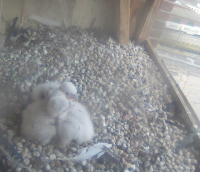 By day 11, the beak is already beginning to acquire a slightly yellow tinge, as opposed to the pink color it has had to this point in the chick’s development. In regard to feeding behavior, hungry chicks solicit even if the adult arrives without food, but when satiated they remain indifferent. R. W. Nelson observed that chicks tend to form a semi-circle in front of the parent or to one side and all received portions of the prey item. Another researcher found that each chick was fed in turn until satiated, when it dropped back and was replaced by the next in line. After 10-12 days, chicks which called most received the most food
By day 11, the beak is already beginning to acquire a slightly yellow tinge, as opposed to the pink color it has had to this point in the chick’s development. In regard to feeding behavior, hungry chicks solicit even if the adult arrives without food, but when satiated they remain indifferent. R. W. Nelson observed that chicks tend to form a semi-circle in front of the parent or to one side and all received portions of the prey item. Another researcher found that each chick was fed in turn until satiated, when it dropped back and was replaced by the next in line. After 10-12 days, chicks which called most received the most food